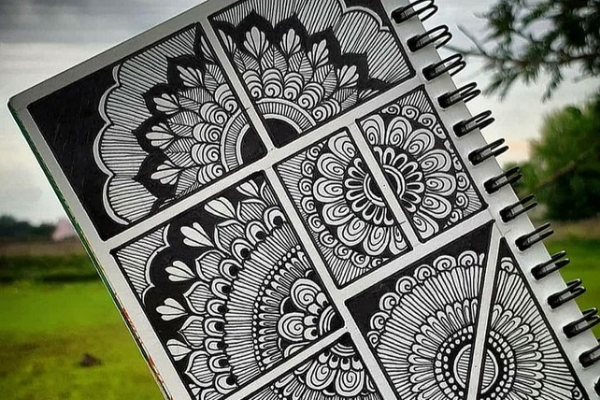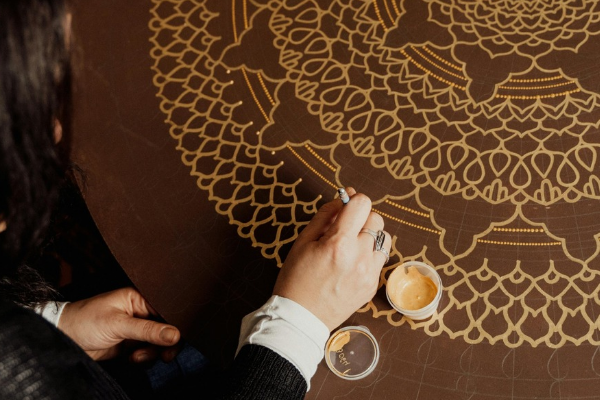Mandala art
Hello and welcome to my blog! Today, I’m excited to share something truly special with you—Mandala Art. Whether you’re an art lover or just curious, I hope you find this journey into the world of mandalas as fascinating and fun as I do.
What is Mandala Art?
Mandala art is all about beautiful geometric designs. The word “mandala” comes from Sanskrit, meaning “circle.” Mandalas are usually circular designs with lots of intricate patterns that spread out from a central point. These designs aren’t just pretty to look at—they also have deep spiritual meanings.
A Little History of this art
Mandala art has been around for centuries, especially in Hinduism and Buddhism. In these traditions, mandalas are used as spiritual symbols and tools for meditation. They represent the universe and the idea that everything is connected. The patterns and symmetry in mandalas help people focus and find inner peace.
In Hinduism, mandalas are used in rituals and ceremonies to symbolize the cosmos and divine order. In Buddhism, they help with meditation and symbolize a journey from the outer world to the inner sacred space. Tibetan Buddhist monks even create detailed mandalas out of colored sand, which can take days to complete, showing the impermanence of life.

Over time, mandala art has spread across the world and inspired many artists. Each person who creates a mandala adds their unique touch to this ancient tradition.
4 benefits of Mandala art
- Calming Effect: Creating or looking at mandalas can make you feel calm and relaxed. The repeating patterns and symmetry can help reduce stress.
- Rich Symbolism: Every part of a mandala has meaning. The center usually represents yourself or the universe, while the outer patterns can symbolize different parts of life and nature.
- Creative Freedom: Mandala art lets you be as creative as you want. You can choose your own patterns, colors, and designs, making each mandala one-of-a-kind.
- Mindfulness and Meditation: Drawing mandalas can be a form of meditation. It helps you stay focused on the present moment and can bring a sense of inner peace.
How to Create Our Own Art ?
Making your own mandala is easier than you might think. Here’s a simple guide to get you started:
- Gather Your Supplies: You’ll need some paper, a pencil, an eraser, and colored pens or markers.
- Draw a Circle: Use something round, like a bowl or a compass, to draw a circle on your paper.
- Find the Center: Mark the center of the circle with a dot. This is where you’ll start your design.
- Draw Guidelines: Draw lines from the center to the edge of the circle, like spokes on a wheel. These lines will help you keep your design symmetrical.
- Start Designing: Begin drawing patterns from the center outward. Use shapes like circles, triangles, and petals. Let your creativity flow!
- Add Color: Once you’re happy with your design, color it in. Choose colors that you like and that make your design pop.
- Enjoy the Process: Remember, creating a mandala is about enjoying the process as much as the finished piece. Take your time and have fun with it.

Best Materials for Creating Mandala Art
Creating mandala art can be a delightful and meditative process. Having the right materials can make a big difference in the quality of your work and your overall experience. Here’s a list of the best materials to consider for your mandala art projects:
1. Paper
Types to Consider:
- Drawing Paper: Smooth surface and good for detailed work.
- Watercolor Paper: Thicker and textured, ideal for watercolors and mixed media.
- Black Paper: Creates a striking contrast with white and metallic pens.
Recommendation: Strathmore Drawing Paper, Canson Watercolor Paper.
2. Pencils
Types to Consider:
- Graphite Pencils: For sketching and outlining. Get a range from hard (H) to soft (B) for different shading effects.
- Mechanical Pencils: For fine lines and details.
Recommendation: Faber-Castell Graphite Pencils, Pentel GraphGear 1000 Mechanical Pencil.
3. Erasers
Types to Consider:
- Kneaded Erasers: For gentle erasing and adjusting lines without damaging the paper.
- Vinyl Erasers: For clean and precise erasing.
Recommendation: Prismacolor Kneaded Eraser, Staedtler Mars Plastic Eraser.
4. Rulers and Geometry Tools
Types to Consider:
- Rulers: For straight lines and precise measurements.
- Compasses: For drawing perfect circles.
- Protractors: For accurate angles.
- Templates: For consistent shapes and patterns.
Recommendation: Staedtler Compass, Helix Angle and Circle Maker.
5. Pens and Markers
Types to Consider:
- Fineliners: For detailed and precise line work.
- Gel Pens: For smooth, vibrant colors and special effects.
- Brush Pens: For varying line thickness and calligraphy-style effects.
Recommendation: Sakura Pigma Micron Pens, Uni-Ball Signo Gel Pens, Tombow Dual Brush Pens
These materials are more than enough to create your first mandala art.But if you want, you can create mandala art with watercolors or acrylic colours as well.

Summary
Mandala art is more than just beautiful patterns; it’s a way to express yourself, find peace, and connect with centuries-old traditions. Whether you want to relax, meditate, or just try something new, mandalas are a great choice. I hope this introduction inspires you to explore the world of mandalas and maybe even create your own.
Thank you for joining me on this artistic adventure. Stay tuned for more fun topics and happy creating!
Table of Contents
Follow Artup for more art related ideas/blogs💡
By – keshava upadhya